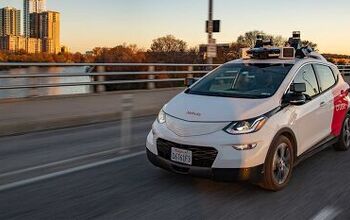Enforcement Works In The War On Distraction… But Only To A Point
Transportation Secretary and Supreme Allied Commander in the War On Distraction Ray LaHood is quite chuffed about initial pilot program results for his latest offensive against in-car cell phone use, and he’s taking to the airwaves to declare victory. The programs, modeled on the “Click It Or Ticket” and “Over The Limit, Under Arrest” initiatives combined an advertising blitz and waves of enforcement to crack down on the behavior, but more importantly to send the message that distracted driving is as serious a problem as drunk driving or not wearing a seatbelt. Thanks to the relative success of these earlier programs, the DOT has a strong template for its pilot anti-distracted driving campaign, the enforcement components of which took place in April, July, and October 2010 and March-April 2011. But was the “Phone In One Hand, Ticket In The Other” program actually as successful as LaHood claims?
Based on data from the report’s finding [ PDF], it seems fairly clear that the program made some difference… but the contrast between the results in Hartford and the results in Syracuse are a little surprising. New York has had a ban on in-car hand-held cell phone use since 2001, and accordingly Syracuse’s initial numbers were relatively low compared to Hartford’s, where a “hands free” law has only been on the books since 2005. Unsurprisingly, Hartford saw the largest declines that can be attributed to the program, with observations of drivers holding phones to their ears dropping from 6.8% to 2.9%, nearly double the drop observed in Syracuse.
Another interesting result is the seemingly organic drops in in-car handheld cell phone use in the control groups, because here the dynamic reverses itself. New York, with its long-standing ban on handheld cell phone use saw stronger decreases in the control group than Conneticut with its more recent ban. As NHTSA’s report puts it
Generally there was a steady decline in the comparison sites, as well. This is a promising finding and suggests that social norms towards phone use and texting while driving may be shifting, becoming less acceptable behaviors to the public.
This is difficult to argue with, but in the context of evaluating the program’s effectiveness, it almost proves that the program was unnecessary. Connecticut’s more recent law meant there were more lower-hanging fruit for enforcement officers in Hartford, but their efforts made less of an impact in the control cities of Bridgeport/Stamford. Meanwhile, New York’s results were less dramatic in the targeted area (Syracuse) but the organic declines in Albany were stronger than any in Connecticut. The lesson? Media and enforcement blitzes do make a difference, but so does passing a law and simply waiting. The longer a law has been in place, the more diminished the returns will be in the targeted area… and the stronger the declines will be in non-targeted areas.
Weigh these results against the not-inconsiderable costs of the program (anyone know what police make per hour on average?) and the results of the program are a little less overwhelmingly impactful than LaHood makes them out to be. Like any other change in social norms, the key ingredient seems to be not advertising dollars nor cops on the beat, but simply time. The longer a law is on the books, the more it seems to be respected… and at a certain point, more advertising and enforcement seem to deliver diminishing returns. On the other hand, the program does seem to be effective at accelerating declines in observed handheld cell phone use… and given the human cost of distracted driving, it does feel a bit churlish to get too worked up about half a million taxpayer dollars (not counting the opportunity cost of dedicated law enforcement hours). So yes, the program was a success (certainly compared to LaHood’s annual hand-wringing “summits” on distracted driving)… but let’s not pretend that anything will be more effective at changing behavior than laws and the progress of time.
More by Edward Niedermeyer
Latest Car Reviews
Read moreLatest Product Reviews
Read moreRecent Comments
- Calrson Fan Jeff - Agree with what you said. I think currently an EV pick-up could work in a commercial/fleet application. As someone on this site stated, w/current tech. battery vehicles just do not scale well. EBFlex - No one wanted to hate the Cyber Truck more than me but I can't ignore all the new technology and innovative thinking that went into it. There is a lot I like about it. GM, Ford & Ram should incorporate some it's design cues into their ICE trucks.
- Michael S6 Very confusing if the move is permanent or temporary.
- Jrhurren Worked in Detroit 18 years, live 20 minutes away. Ren Cen is a gem, but a very terrible design inside. I’m surprised GM stuck it out as long as they did there.
- Carson D I thought that this was going to be a comparison of BFGoodrich's different truck tires.
- Tassos Jong-iL North Korea is saving pokemon cards and amibos to buy GM in 10 years, we hope.

































Comments
Join the conversation
Here in Syracuse it may have made a little difference while the program was running, but no apparent differrence any more. But I'm so glad Roy DuhHood has declared himself a success. Not many others would.
To a degree, I agree that excessive cell phone usage while driving is indeed a distraction, as is excessive conversation with your passenger instead of concentrating on the traffic before and behind you. But that said, it's HOW Ray Lahood is going about it that he needs to put a sock in it and STFU. He's no better than the self righteous pompus left and right wingers we see everywhere these days wanting to control our lives for their pleasure if they can.